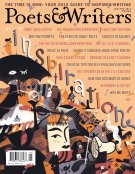“And Mandela was stirred by this story,” Williams continues. “He saw Makhanda as the first freedom fighter against white domination. So it struck me as being ironic that Mandela was aware of this man and that he himself was then imprisoned and went about the same fate as his hero. This irony—this echo of history that comes down—I thought was so interesting.”
Williams explains that through the writing of the piece he’d also realized that the first half was about the mistakes Mandela had made as a young man—stealing cattle from his surrogate father in order to run away and avoid an arranged marriage; his infidelity during his first marriage and eventual divorce; and promoting violent change, which was against the wishes of the African National Congress—and that the second half was about the success that he had—his courage and leadership at the 1956 treason trial and the years he spent in prison; the gentle manner in which he dealt with the increasingly radical demands made by his second wife, Winnie; his firm but conciliatory handling of the negotiations with De Klerk’s government; and his vision of a new, non-racial South Africa when he became President. So the piece was really about looking back, about seeing the arc of a life in the context of all this history.
To capture this, Williams has decided to set the entire show in the prison yard of Robben Island, where Mandela spent eighteen years of his twenty-seven-year imprisonment. An older Mandela, looking back on his life, would both summon the memory of those prisoners like himself and summon their memories—of their youth, their indiscretions, their passions, their struggles—made even more poignant by the prison walls in the background, which despite the evolving time and place of each scene would linger in the background. For there is both liberation and limits to memory; the imagination can soar over walls but remain aloft for only so long. It is the tension between these two forces which creates meaning.
For the first hour and a half of rehearsal, however, most of the work is devoted to the new music, and Williams sits on a chair in front of the desk, following along as the conductor walks the singers through their parts. An accompanist on the piano provides the melody. There are duets between a young Mandela and his brother, Justice, the son of the Thembu Regent Jongintaba Dalindyebo, in whose family Mandela was a ward, as they consider fleeing their arranged marriages; there is the upbeat tribal song celebrating the intiation ceremony that the young men must go through; and there is a soaring aria by a woman playing Mandela’s mother, who must say goodbye to her son twice—once as he leaves the village as a young man, and again (perhaps for good) upon his imprisonment—a song that even in rehearsal brings two of the female cast members to tears, and leaves the room ringing all the way to the steel beams of the rafters. It is, in a word, amazing.
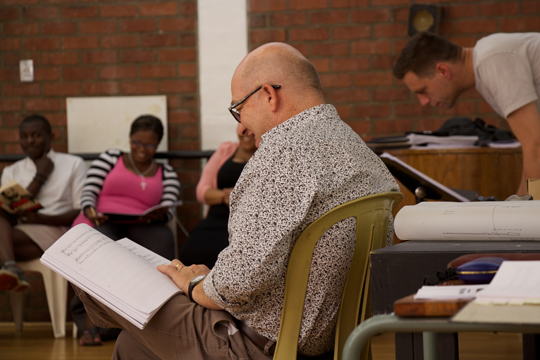
That said, the performance doesn’t truly come alive until Williams begins the blocking process—that is, working with the performers to direct the action that will take place on stage. Shortly before we break for lunch, Williams brings the company together to start exploring the opening of Act One. The chairs have been pulled aside and the dance floor of the rehearsal room cleared. The cast stand in a semi-circle in front of the mirrored wall, some leaning up against the barre, and Williams begins evoking the stage. He does so by moving across floor, gesturing the shape of the set with his hands as he speaks—here is the catwalk where the guards will watch the prisoners, there and there the two set of stairs that will flank the stage; here is where the men will enter in their prison dress, and over there where an older Mandela will stand, looking on.
As Williams explains to the performers how the stage will be configured, how they will physically interact with one another and the set, an entirely new energy begins to fill the room. Not simply because of the excitement of the new opening act, which the performers seem to enjoy, but because the process of blocking the stage is such a collaborative one; Williams clearly has a vision for the performance, but I’m inspired by the easy way the company weighs in with suggestions about entrances and exits, how the choreographer works with Williams and the performers as she begins to turn his ideas into movement and dance, and how Williams himself coordinates with the rest of the staff on everything from props to lighting to costumes to timing so that their input might help bring Act One to life.
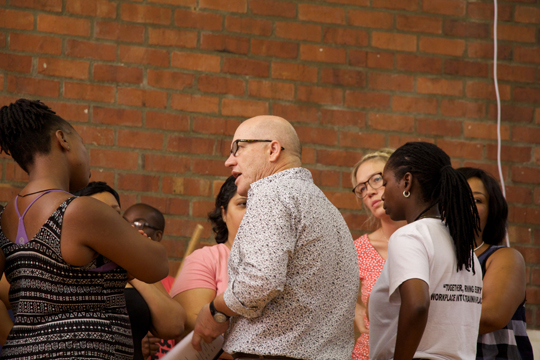
And even as the performers begin weaving the music and action together on stage, Williams stays on his feet, walking them through each moment, coaching the singers both in terms of motivation and the mood. At times he suggests a particular inflection, or pushes them into a deeper emotional register, helping them find the character in the music and vice-versa. It is a magical thing, this delicate balance of coaching while managing to stay out of the way of a performer’s own exploration of a scene. Throughout the process Williams solicits feedback from the cast, and urges them on with excitement when they stumble upon something new. Together, they are uncovering the mystery and movement of the show as they rehearse.
Finally, after the cast has practiced isolated bits and pieces of Act One, Williams decides to run straight through from the beginning. The scene is to open with half a dozen men in prison uniforms sitting in the prison yard. They are Mandela’s memory of his own past, one he views from the wings. The lights are dim, and from the back of the prison comes the flicker of a candle. The candle is held by a woman, a memory of village life. Mandela steps toward her, welcoming her into this dream, summoning her into the scene. One by one women follow her slowly across the stage, each holding a small bowl with a candle. They circle two galvanized wash tubs that sit in the center of the stage—tubs that a young Mandela and his brother, Justice, will soon use to wash the white clay of their initiation ceremony off their bodies. But the memory of that past hasn’t been fully evoked yet. The prisoners, watching the women now, slowly begin to stand, and as the scene unfolds, these prisoners will shed their prison garb, revealing the Xhosa tribal clothes they once wore, the memory of their younger days burning bright enough to conjure their younger, freer selves to life. For the memory of the village punctures the reality of the prisonyard, transforming it—evolving—before our eyes from incarceration to home.
This is, of course, not exactly what I see in the dance studio during rehearsal. It’s what I remember now, months later, the memory taking its own shape through the magic of the afternoon. But somehow it feels real. And I know it’s what will have been born on the stage in the weeks and months that follow my departure.
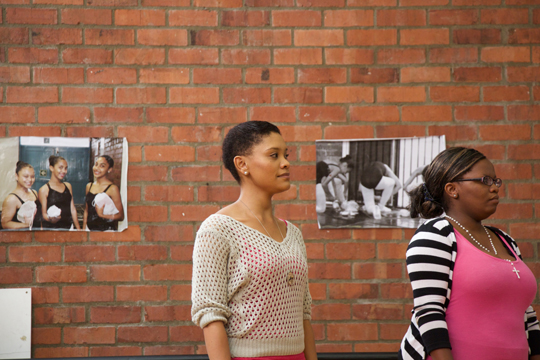
I think to the other lecture that Williams gave on our voyage, this one on the history of African theater. He began by saying, “As you all know, theater is an act. To brush one’s teeth in public is not theater, but to mimic someone brushing ones’s teeth becomes art and that is theater—the urge to imitate, the need to act out life, and the belief that in this act, in this acting out, in some mysterious way, this affects the natural world—our world—that we live in.”
I feel that transformative power in the Joseph Stone theater. And in witnessing this opening scene as it is practiced over and over throughout the rest of the day, I think I finally glimpse Williams’s larger vision for the play, see it flicker as those candles would on stage. For what’s most inspiring about this vision of Mandela’s story is that by structuring the entire piece as a memory built around the prison, one is asked to see how the present and the past collapse into one another, how they become inseparable, forming and informing one another, gesturing toward a future that has happened and has yet to happen. That opening scene illuminates the way in which the past lives inside us, how it can both drown us and set us free.
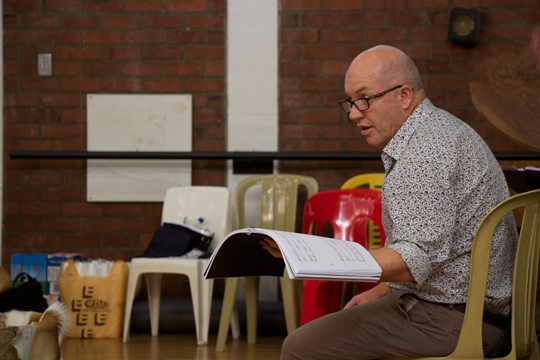
That was Mandela’s gift, after all, wasn’t it? He was able to forgive those who had imprisoned him in the prime of his life. “His way was to conquer fear of the other in South Africa,” Williams had said at his first talk. “So that he could bring the warring factions together in the spirit of reconciliation. He found a way to do that. He succeeded because he was able to give himself as an example of forgiveness.” And perhaps, in doing so, liberate himself from that past as well.
![]()
At the end of rehearsal, as the company gathers its things to leave, Williams thanks me for the visit. He has to stay to work late with the stage manager and to oversee the completion of the set. If all goes well this evening, the company will begin to rehearse on stage tomorrow. I still need to get back to Cape Town, so Williams arranges to have me ride back with some of the company, who are taking the Cape Town Opera van back to the city. I’ll be dropped at Artscape, and from there I can get a taxi to the ship.
The van is already waiting for me, so I say my goodbyes quickly. I wish Matthew well, thank the rest of the crew who have let me observe, and haul myself and my camera bag into the vehicle. The only seat available is at the very rear, and I excuse my way to the back of the bus.
The cast is tired. A day worth of summoning their voices and learning new choreography and stage directions has clearly worn most of them out. They speak a little—mostly Xhosa, I’m guessing, with a stray line or two in English—and occasionally someone half-sings a line in practice, adjusting a note slightly, then trying again. But mostly they are quiet. I manage a “thank you” for letting me observe, and offer some very genuine words of admiration. They offer small gratitudes in return. But it’s clear from everyone’s body language that they are exhausted and not up for conversation.
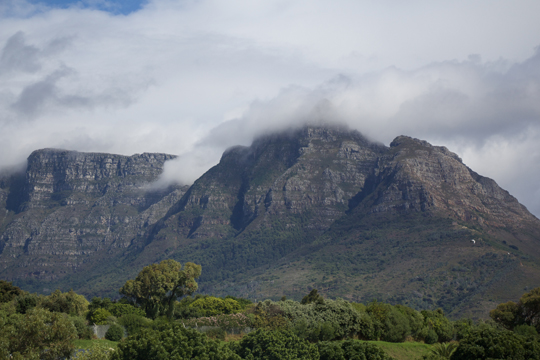
So I lean back in my seat, as well. I stare out through the dust on the window at the light striking down from the sky. Williams’s novels are full of dust and light. “Outside, the sun rested above the thorn trees and the air filled with amber dust,” Patson narrates on the first page of Diamond Boy. He, too, was staring out the window of a car, headed somewhere new. In the distance, the back side of Table Mountain is coming into view, a side of it I haven’t seen before. It feels strange to see it in this way, so different and yet so much more intimate than the perfect, postcard images one always sees taken from the harbor.
Jeremiah Chamberlin is a contributing editor of Poets & Writers Magazine.
[Photos, from top]
Photo 1: Michael Williams with some of the company members (back, left) during a moment of levity. Albert Horne, conductor and chorus master (back, right) reviewing the score.
Photo 2: Williams and choreographer Sbo Naka (immediately to Williams’s right, back to camera) talking to some of the company about a scene in Act One.
Photo 3: Two of the company members awaiting their cues during rehearsal.
Photo 4: Williams during rehearsal.
Photo 5: The back of Table Mountain.







